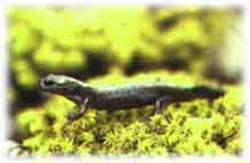| Go To : TWL Annex : PetHobbyist.com : kingsnake.com |
|
||||||||||||||||||||||||||||||||||||||||
Where Do Salamanders Come From?
Part 1
by Terry Gampper
email PHFrog
The following is based on the research of Russian herpetologist, Alexander Michailovitch Nikolski (1858-1942). He worked at the museum in St. Petersburg (Leningrad during the Soviet regime). He had written several books including Herpetologia rossica (1905) describing the herpetofauna of Russia and adjacent countries. I have included some notes at the end of the article to bring the reader up-to-date on current "herpetological thinking".
The study of amphibians can reveal much about the biogeographic history of the Earth's continents. It is widely known that from the earliest times, amphibians always inhabited fresh water areas. The distribution and size of fresh water basins and changes in climate can be determined by studying the distribution patterns of the amphibians throughout the world.
The amphibians were the first group of vertebrates to inhabit the land. The earliest fossils of true amphibians were found in the Devonian (300 million yews ago) rocks of Greenland and Canada. These early amphibians evolved from Crossopterygian (or lobe-fined) fishes. Amphibians, unlike the reptiles, birds, and mammals, which evolved later, have not properly solved the problem of getting away from water or moist areas. Nearly all species must return to the water to breed.
North America has the greatest diversity of salamanders, with eight of the nine families represented and one-third of the world's species. Other significant populations are found in Asia, Europe, and South America. On the basis of diversity alone, can we conclude that salamanders evolved in the Americas and later migrated to Asia and Europe?
The Asiatic salamanders exhibit certain features that indicate a very old origin and advanced signs of extinction. Studies of genera composition and distribution shows that nearly all genera of Asiatic salamanders are monotypic (single species) and their ranges are highly discontinuous (limited ranges that are separated by great distances). In his study, Nikol'skii identifies six genera of salamanders, which supports his claim. The genus Hynobius has seven species, five are found in Japan, one in Korea, and one in Turkestan (*1). The genus Salamandrella has one species endemic to Siberia. Ranodon has two species, one in the Tyan-Shan (*2) region and the other in Turkestan. The genus Onychodactylus has three species, two in Japan and one in the Ussuri Territory. The last two genera are monotypic, Geomolge in the Ussuri Territory (*3) and Turanomolge in Turkestan. The lack of diversity and the widely scattered ranges of the Russian salamanders indicates that the extinction processes has been going on for quite some time and those salamanders living today are survivors of a once rich fauna. Discontinuous ranges among the Asiatic amphibians is a result of harmful effects of the "ice ages". Countries of mountainous Asia - Tibet, Mongolia, and Turkestan can be considered places where salamanders first appeared. The plains of Central Asia were once covered by a large network of fresh water lakes fed by nearby mountain streams. As a result of fairly recent (geologically speaking) climatic changes, the lakes were subject to strong evaporation and soon dried up or became salty. Following the drying up of fresh water lakes, the region became and most of the amphibians disappeared. M. A. Menzbir, a Russian geologist, reports:
"... that the central Asiatic countries became desert during the Eocene (55 million years ago). That these deserts have actually an old origin also follows from the fact that very specific endemic genera appeared there. If the formation of these deserts occurred in the Eocene, then the period of the maximum size of the central Asiatic lake system must be in place before the Eocene epoch. These ancient lakes undoubtedly presented very favorable conditions for the development of amphibians. The most favorable time for the transformation of aquatic amphibians into semi aquatic forms, with temporary gills, must have been the period of increased drying up of these lakes. It is possible that then there were many small lakes which existed only in the rainy season and, since they periodically dried up, they provided excellent conditions for transforming aquatic animals into terrestrial ones."
To summarize, the Asiatic salamanders once had a much wider distribution and as a result been prone to large scale extinction. Only a few survivors remain today. The Asiatic amphibians moved northeastward from central Asia to the Americas over the Bering Strait land bridge. In North America, the immigrant salamanders found plenty of fresh water and favorable climate for growth.
 A Note on Russian Geography
A Note on Russian Geography
(*1) Turkestan Territory is now part of the independent nations of Kazakhstan
and Uzbekistan (formerly of the USSR).
(*2) Tyan-Shan is a mountain range in Kyrgyzstan (independent nation,
formerly of the USSR).
(*3) The former Ussuri Territory is located in southern Khabarovsk Territory
(near Vladivostok, eastern Russia).
A Note on Asiatic Salamander Classification
Asiatic salamanders currently belong to the family Hynobiidae and along with the Cryptobranchidae, are the most primitive of recent salamanders and newts. Of the six genera mentioned above, only Hynobius, Ranodon, and Onychodactylus are currently valid. Salamandrella is a synonym for Hynobius (however many herpetologists today consider the monotypic genus Salamandrella valid). Geomolge is a synonym for Onychodactylus and Turanomolge is a synonym for Hynobius. Nikol'skii places the Asiatic salamanders in the family Ambystomidae. Species in the family Ambystomidae are found only in the United States, Canada, and Mexico.
Sources:
Menzbir, M. A., Zoologicheskie uchastki Turkestanskogo kraya (The Zoological Regions of Turkestan Territory, pg. 111, 1914 (in Russian).
Nikol'skii, A. M., Fauna Rossii i sopredel'Rykh stran/Zemngyodnye (Fauna of Russia and Adjacent Countries/Amphibians), National Science Foundation, Washington DC, 1962. In English. Originally published in Russian, 1918.
Notes:
This article was originally published in the Newsletter of the Nebraska Herpetological Society, Vol. 13, No. 2.
|
 |
This page is maintained by The
Wyvern's Lair.
Contact the webmaster : E-MAIL. © 2004, The Wyvern's Lair |
Visitors since November 2004 |
